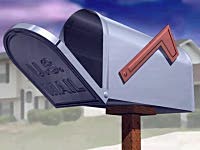
 |
Some U.S. Rates To Go Up July 1
 The U.S. Postal Service is finally getting the rates it wants — because it's taking matters into its own hands.
The U.S. Postal Service is finally getting the rates it wants — because it's taking matters into its own hands.In a closed session Monday, May 7, 2001 (announced Tuesday), the agency's Board of Governors voted unanimously to override recommendations made by the Postal Rate Commission late last year, and institute higher rates for some classes of mail.
A unanimous vote was required to bypass the PRC.
In most cases, the new rates that go into effect July 1 are what the USPS had requested early last year.
The basic price of mailing a letter will remain at 34 cents. However, additional ounces will be 23 cents, not 21 cents. Until the decrease January 7, that rate had been 22 cents.
Postcards will go from 20 cents to 21 cents, after the independent PRC turned down four previous requests from the Postal Service.
There will be no change in Priority Mail rates — the rate commission gave the USPS more than it had requested — but Express Mail, which competes directly with services like Federal Express, will go up more than had been proposed previously.
Fees for Certified Mail and domestic money orders will both rise, to the levels requested in the original request.
| Item One-Ounce Letter Two-Ounce Letter Three-Ounce Letter Postcard One-Pound Priority Two-Pound Priority Flat-Rate Priority Half-Pound Express Mail Two-Pound Express Mail Flat-Rate Express Mail Certified Mail Money Orders | 34¢ 55¢ 76¢ 20¢ $3.50 $3.95 $3.95 $12.25 $16.00 $16.00 $1.90 75¢ | 34¢ 57¢ 80¢ 21¢ $3.50 $3.95 $3.95 $12.45 $16.25 $16.25 $2.10 90¢ |
"Standard mail," what many of us call "junk mail" but the Postal Service calls bread-and-butter, is going up 1.4% to 2.0% on July 1. Non-profit standard mail rises 2.0-2.5%, while periodicals go up 1.6-2.6%, USPS spokesman Mark Saunders told the Virtual Stamp Club.
From a chart prepared by the Direct Marketing Association comparing "before" and "after" rates for "standard" mail, it appears that all rates for standard-size standard mail are up $0.003 (3/10 of a cent). That works out to 1.2% on a piece that's currently $0.250.
By comparison, a two-ounce letter just went up two cents, or 3.6%. A three-ounce letter went up four cents, or just over 5%.
A postcard went up one cent, or 5%.
It could be argued that all standard mail is, to some extent, pre-sorted by the mailer and never, ever hand-addressed.
Cash-Strapped Agency
The USPS' board had accepted the rate recommendations under protest last December.
"We found that the additional revenue is essential and is adequately supported in the record compiled before the Commission," said chairman Robert F. Rider said in a statement.
The Postal Service claims it is facing a loss this year that could exceed $2 billion, blaming "a variety of factors, including a weakening economy and soaring fuel and personnel expenses." Its major labor contracts are under negotiation.
The agency already has stopped more than 800 construction projects, making sure every local community knew about them. Postmaster General William Henderson also suggested to Congress that the Postal Service could end Saturday delivery. In a public radio interview recently, he said that Wednesday or Thursday suspensions might be instituted instead of Saturday.
Most observers believe that's just saber-rattling designed to get attention and get the Postal Service what it really wants: Reform of the 1971 act that forces the agency to submit its rate increase requests first to the Postal Rate Commission. That process takes most of a year. The USPS wants to be able to change its prices the way its competitors do: When and as it sees fit.
Long negotiations and hearings produced a bill they felt would solve many of their problems last year, but the measure never came up for a vote and died with the end of the last Congress.
The USPS had a $199 million loss last fiscal year, after five years in the black during which it was able to reduce, but not eliminate, accumulated losses from earlier years. Under the law, the agency is required to break even over time.
The 1971 establishment of the U.S. Postal Service as a quasi-independent government-owned corporation also eliminated patronage as the avenue for management jobs — Postmasters General were often former presidential campaign managers — but still left the USPS saddled with cumbersome labor and hiring practices.
Another Round Of New Stamps?
Don't expect new stamps for the new rates until after the rate change goes into effect July 1, USPS spokesman Don Smeraldi told the Virtual Stamp Club, nor a reissued two-cent stamp.
"Everyone's saying there are so many one-centers out there that that's probably what we'll use," he said.
What Do You Think?
Join us in the message board for the latest news and discussion.
When there's stamp and postal news, the Virtual Stamp Club is always among the first to have it — and it has it first in its message board.